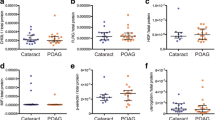Abstract
Insulin-like growth factor-1 (IGF-1) is altered in several neurodegenerative diseases, the association between serum IGF-1 levels and glaucoma has not been evaluated. This study was designed to evaluate whether serum IGF-1 levels are different in patients with Pseudoexfoliation (PEX) with or without glaucoma. The study was conducted with 110 participants aged 65 years or older who were divided into three groups: group 1, patients with PEX syndrome; group 2, patients with PEX glaucoma; and group 3, participants without PEX or glaucoma. All participants underwent full ophthalmological examination and a detailed medical history was recorded. Patients with known neurodegenerative diseases other than PEX glaucoma were excluded. Serum IGF-1 levels were measured by automated chemiluminescent assay. Groups 1, 2, and 3 included 35, 34, and 41 patients, respectively; there were no differences regarding age, gender, or systemic disease status. There were also no statistically significant differences between the groups in terms of IGF-1 levels, which were 91.7 ± 39.1, 101.1 ± 40.2, and 107.2 ± 43.8 ng/ml for groups 1, 2, and 3, respectively (p = 0.276). Serum IGF-1 levels were similar by gender, the presence of systemic disease, status of diabetes mellitus, and laterality of the PEX material. There was no correlation between the cup-to-disk ratios and IGF-1 levels (r = −0.214, p = 0.223). IGF-1 levels in the circulation did not differ in the presence of PEX syndrome with or without glaucoma. This may indicate that the neurodegenerative process is local rather than systemic.
Similar content being viewed by others
References
You QS, Xu L, Wang YX, Yang H, Ma K, Li JJ, Zhang L, Jonas JB (2013) Pseudoexfoliation: normative data and associations: the Beijing eye study. Ophthalmology 120:1551–1558
Schlötzer-Schrehardt U, Naumann GO (2006) Ocular and systemic pseudoexfoliation syndrome. Am J Ophthalmol 141:921–937
Ovodenko B, Rostagno A, Neubert TA, Shetty V, Thomas S, Yang A, Liebmann J, Ghiso J, Ritch R (2007) Proteomic analysis of exfoliation deposits. Invest Ophthalmol Vis Sci 48:1447–1457
Ritch R (2014) Ocular and systemic manifestations of exfoliation syndrome. J Glaucoma 23(8 Suppl 1):S1–S8
Ekström C, Kilander L (2014) Pseudoexfoliation and Alzheimer’s disease: a population-based 30-year follow-up study. Acta Ophthalmol 92:355–358
Salmon WD Jr, Daughaday WH (1957) A hormonally controlled serum factor which stimulates sulfate incorporation by cartilage in vitro. J Lab Clin Med 49:825–836
Puche JE, Castilla-Cortázar I (2012) Human conditions of insulin-like growth factor-I (IGF-I) deficiency. J Transl Med 10:224
Ohlsson C, Mohan S, Sjögren K, Tivesten A, Isgaard J, Isaksson O, Jansson JO, Svensson J (2009) The role of liver-derived insulin-like growth factor-I. Endocr Rev 30:494–535
Arvat E, Broglio F, Ghigo E (2000) Insulin-Like growth factor I: implications in aging. Drugs Aging 16:29–40
Kilani RT, Guilbert L, Lin X, Ghahary A (2007) Keratinocyte conditioned medium abrogates the modulatory effects of IGF-1 and TGF-beta1 on collagenase expression in dermal fibroblasts. Wound Repair Regen 15:236–244
Vesti E, Kivela T (2000) Exfoliation syndrome and exfoliation glaucoma. Prog Retin Eye Res 19:345–368
Kang JH, Loomis S, Wiggs JL, Stein JD, Pasquale LR (2012) Demographic and geographic features of exfoliation glaucoma in 2 United States-based prospective cohorts. Ophthalmology 119:27–35
Puska PM (2002) Unilateral exfoliation syndrome: conversion to bilateral exfoliation and to glaucoma—a prospective 10-year follow-up study. J Glaucoma 11:517–524
Wang W, He M, Zhou M, Zhang X (2014) Ocular pseudoexfoliation syndrome and vascular disease: a systematic review and meta-analysis. PLoS One 25(9):e92767
Schlötzer-Schrehardt U, Zenkel M, Küchle M, Sakai LY, Naumann GO (2001) Role of transforming growth factor-beta1 and its latent form binding protein in pseudoexfoliation syndrome. Exp Eye Res 73:765–780
Zenkel M, Pöschl E, von der Mark K, Hofmann-Rummelt C, Naumann GO, Kruse FE, Schlötzer-Schrehardt U (2005) Differential gene expression in pseudoexfoliation syndrome. Invest Ophthalmol Vis Sci 46:3742–3752
Zenkel M, Schlötzer-Schrehardt U (2014) Expression and regulation of LOXL1 and elastin-related genes in eyes with exfoliation syndrome. J Glaucoma 23:48–50
Gartaganis SP, Georgakopoulos CD, Exarchou AM, Mela EK, Lamari F, Karamanos NK (2001) Increased aqueous humor basic fibroblast growth factor and hyaluronan levels in relation to the exfoliation syndrome and exfoliative glaucoma. Acta Ophthalmol Scand 79:572–575
Kara S, Yildirim N, Ozer A, Colak O, Sahin A (2014) Matrix metalloproteinase-2, tissue inhibitor of matrix metalloproteinase-2, and transforming growth factor beta 1 in the aqueous humor and serum of patients with pseudoexfoliation syndrome. Clin Ophthalmol 29(8):305–309
Luppi C, Fioravanti M, Bertolini B et al (2009) Growth factors decrease in subjects with mild to moderate Alzheimer’s disease (AD): potential correction with dehydroepiandrosterone-sulphate (DHEAS). Arch Gerontol Geriatr 49(Suppl 1):173–184
Vardy ER, Rice PJ, Bowie PC, Holmes JD, Grant PJ, Hooper NM (2007) Increased circulating insulin-like growth factor-1 in late-onset Alzheimer’s disease. J Alzheimers Dis 12:285–290
Godau J, Knauel K, Weber K, Brockmann K, Maetzler W, Binder G, Berg D (2011) Serum insulinlike growth factor 1 as possible marker for risk and early diagnosis of Parkinson disease. Arch Neurol 68:925–931
Janciauskiene S, Krakau T (2001) Alzheimer’s peptide: a possible link between glaucoma, exfoliation syndrome and Alzheimer’s disease. Acta Ophthalmol Scand 79:328–329
Koliakos GG, Schlötzer-Schrehardt U, Konstas AG, Bufidis T, Georgiadis N, Dimitriadou A (2001) Transforming and insulin-like growth factors in the aqueous humour of patients with exfoliation syndrome. Graefes Arch Clin Exp Ophthalmol 239:482–487
Ma J, Guo C, Guo C, Sun Y, Liao T, Beattie U, Lopez FJ, Chen DF, Lashkari K (2015) Transplantation of human neural progenitor cells expressing IGF-1 enhances retinal ganglion cell survival. PLoS One 29(10):e0125695
Author information
Authors and Affiliations
Corresponding author
Rights and permissions
About this article
Cite this article
Dogan, A.S., Kabatas, N., Erden, G. et al. Serum insulin-like growth factor-1 levels in patients with pseudoexfoliation syndrome and glaucoma. Int Ophthalmol 37, 371–375 (2017). https://doi.org/10.1007/s10792-016-0271-y
Received:
Accepted:
Published:
Issue Date:
DOI: https://doi.org/10.1007/s10792-016-0271-y




